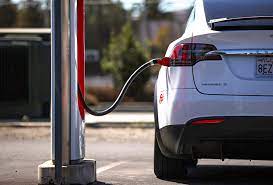The U.S. market is looking increasingly attractive for electric vehicle (EV) producers, as non-traditional EV manufacturers make plans to break into the market. A decade ago, when people thought of EVs one name came to mind – Tesla. Fast-forward a few years and consumers have a vast array of EV options, with more coming to the market every year. Major automakers from Ford to GM have launched EV ranges, in a bid to respond to mounting pressures to decarbonise, as many car manufacturers race to develop the competitive car of the future. The U.S. crossed the tipping point for EV mass adoption earlier this year when 5 percent of all new car sales were fully electric. Hitting this threshold marked the beginning of mass EV adoption according to a Bloomberg analysis. At the beginning of 2022, the U.S. became the third biggest EV market after Europe and China. Based on this achievement, a quarter of U.S. car sales could be all-electric by as soon as 2025, a year earlier than originally predicted. Various thresholds have been used as predictors for popular electronics such as televisions and mobile phones in the past, with the early-adopter phase taking the longest, followed by a quick shift to becoming mainstream after hitting the threshold. Canada, Australia, and Spain are all expected to achieve the 5 percent adoption mark this year.
The U.S. EV market has expanded rapidly and is expected to grow from $28.24 billion in 2021 to $137.43 billion in 2028 at a CAGR of 25.4 percent. The industry was hit hard by the global pandemic in 2020 but has rebounded rapidly. This is largely owing to increasing pressures to decarbonise at the national and international level, with consumers and automakers making the switch from internal combustion engine (ICE) vehicles to electric in line with charging infrastructure developments and more competitive EV pricing.
The U.S. is now the third-largest EV manufacturer worldwide. Several automakers that put the launch of new EV models on hold during the pandemic are now finally seeing an improvement in supply chain disruptions, allowing a wide variety of car makers to break into the EV market this year. This flood of the EV market has been met by eager consumers, with General Motor’s (GM) 2022 EV hummer pre-order selling out in 10 minutes. Ford has also increased its output of the fully electric F-150 by 50 percent in response to rising consumer demand.
And automakers are quickly adding new EV models to their ranges, with several manufacturers aiming for fully-electrified fleets within half a decade. Dozens of all-electric vehicles are expected to launch by the end of 2024, creating a diverse EV market with highly competitive pricing and car features. Gabe Shenhar, associate director of Consumer Reports’ Auto Test Center explained, “These more affordable models have the potential to sway a significant percentage of the car-buying public toward buying an EV with their efficiency, performance, and lower ownership costs.”
And several automakers unknown for their EV business are emerging quickly as major battery-electric playerswith extensive new ranges set for market. Honda announced this month that it plans to partner with Sony to bring its Sony-Honda EV venture to the U.S. market. The partners expect to deliver their EVs to both the U.S. and Japan by 2026. Sony Honda Mobility (SHM) hopes to take pre-orders in 2025, focusing mainly on online sales. It will manufacture the vehicles at a Honda factory in North America and will offer a Level 3 autonomous driving system across the range. This will help it compete with companies such as Tesla, General Motors, Ford Motor Co., and Mercedes Benz which are also offering autonomous driving systems in their vehicles.
The new venture builds upon Honda’s April announcement that its plans to deliver 30 EV models to the global market by the end of the decade. At the time, it said it would be investing $33.9 billion in electrification and software technologies. Sony is largely unknown in the EV world, presenting a prototype electric car at a press event during CES 2020 in Las Vegas, and little since. However, Sony is expected to enhance Honda’s EV software system to provide entertainment and other services that will be billed monthly. SHM hopes its vehicle will function like a ‘rolling smartphone’, although it has not yet released information about the price or battery range.
To date, Tesla is still dominating the U.S. EV market, but other companies such as Ford, Hyundai, Kia, Nissan, and Chevrolet are slowly catching up. While Tesla might be the most well-known EV, other companies developing their EV ranges may have a competitive edge over the electric car giant, as they plan to offer consumers more affordable and longer-range EVs within the next two to five years.

 Iran Energy News Oil, Gas, Petrochemical and Energy Field Specialized Channel
Iran Energy News Oil, Gas, Petrochemical and Energy Field Specialized Channel



